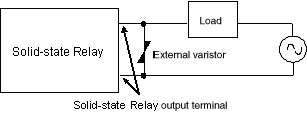Question
Solid-state Relays Output Short-circuit Malfunction 1: Why do the Solid-state Relays output always use half-wave operation?
Answer
The dielectric strength of one Solid-state Relay channel may have deteriorated as a result of an overvoltage to the Solid-state Relays output terminal caused by a noise surge (including high frequency noise).
Solid-state Relays Internal Circuit with Problematic Section

The I/O insulation element of the affected Solid-state Relays circuit may be a photocoupler or a phototriac coupler, and the load switching (output) element may be a thyristor or a triac.
Example of a Phototriac Coupler with Deteriorated Dielectric Strength on One Channel of Optical Receiver
| Positive side | Negative side | |
| Internal phototriac coupler dielectric strength | Normal | Detericration of dielectric strength |
Note:If the dielectric strength deteriorates on both poles, it will lead to a short-circuit error.
Possible Causes
1.A surge voltage was caused by the load power supply, or other loads connected to the load power supply line.
2.An inverter-controlled power supply was used (including harmonic noise).
Reference Information Relating to Protection against External Noise
As protection against external noise, it is recommended that an overvoltage protection element (e.g., a varistor) is externally connected to the power supply line.
Connection Example 1

Connection Example 2

Note:Check the manufacturer’s information for how to connect the overvoltage protection element.
Recommended Products
 MY
MY
New Latching Levers for Circuit Checking Added to Our Best-selling MY General-purpose Relays
 LY
LY
Power-switching Compact General-purpose Relays
 G3PE (Three-phase)
G3PE (Three-phase)
Compact, Slim-profile SSRs with Heat Sinks. Solid State Contactors for Three-phase Heaters Reduced Installation Work with DIN Track Mounting.


